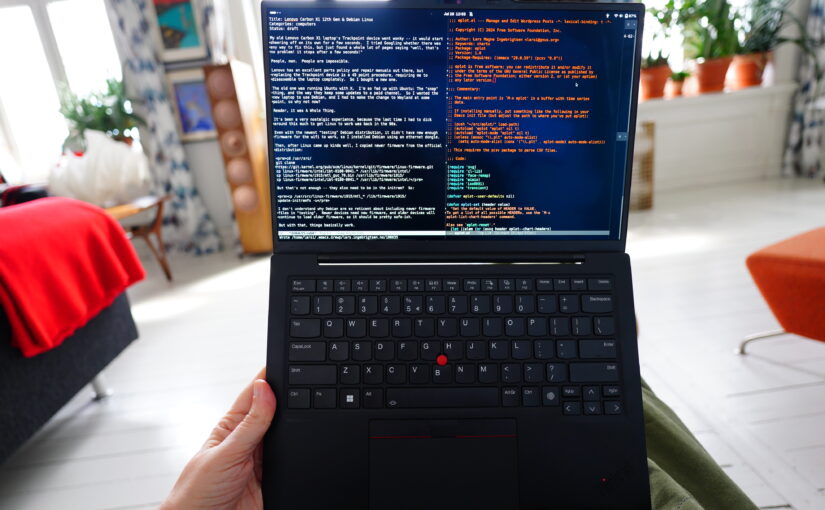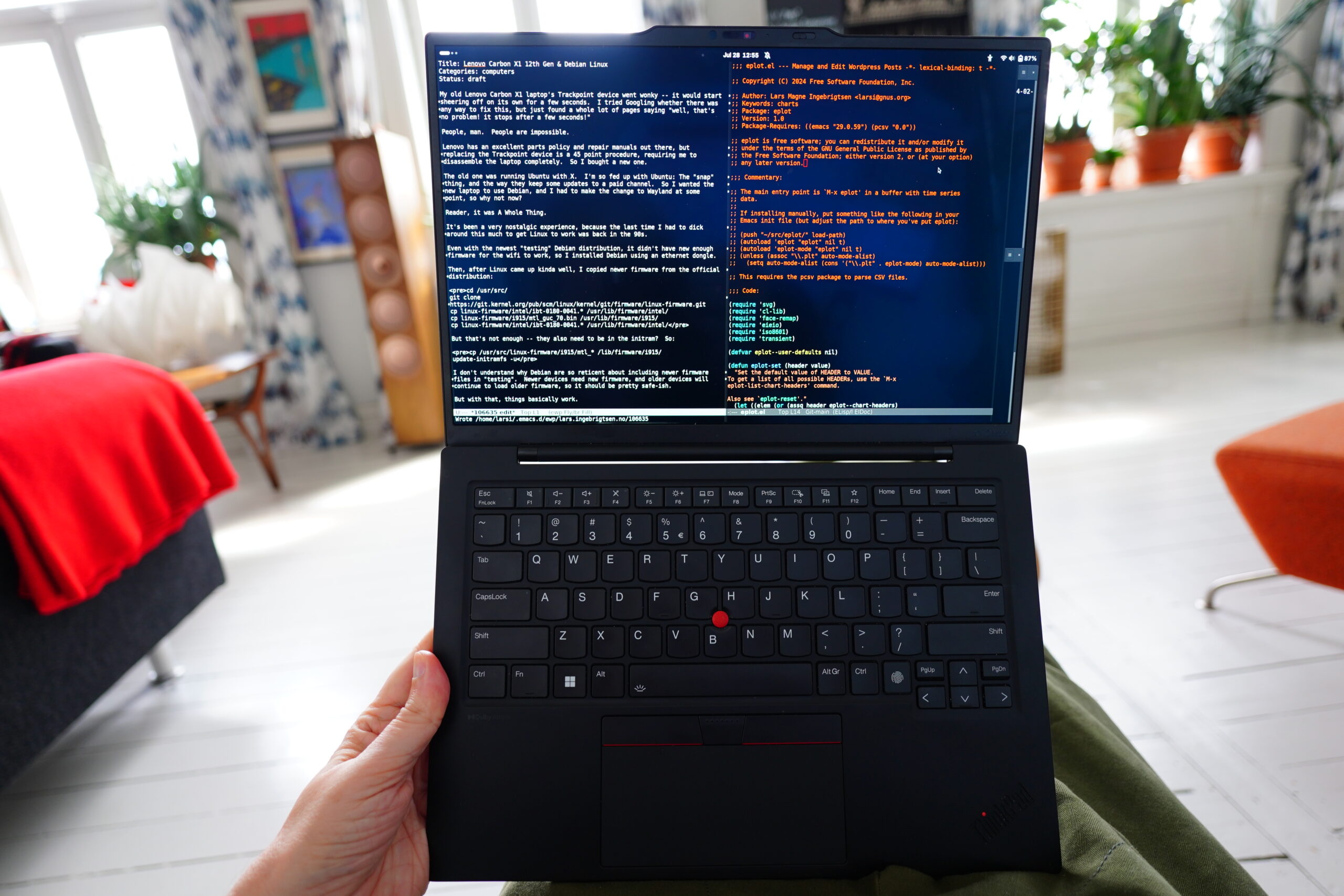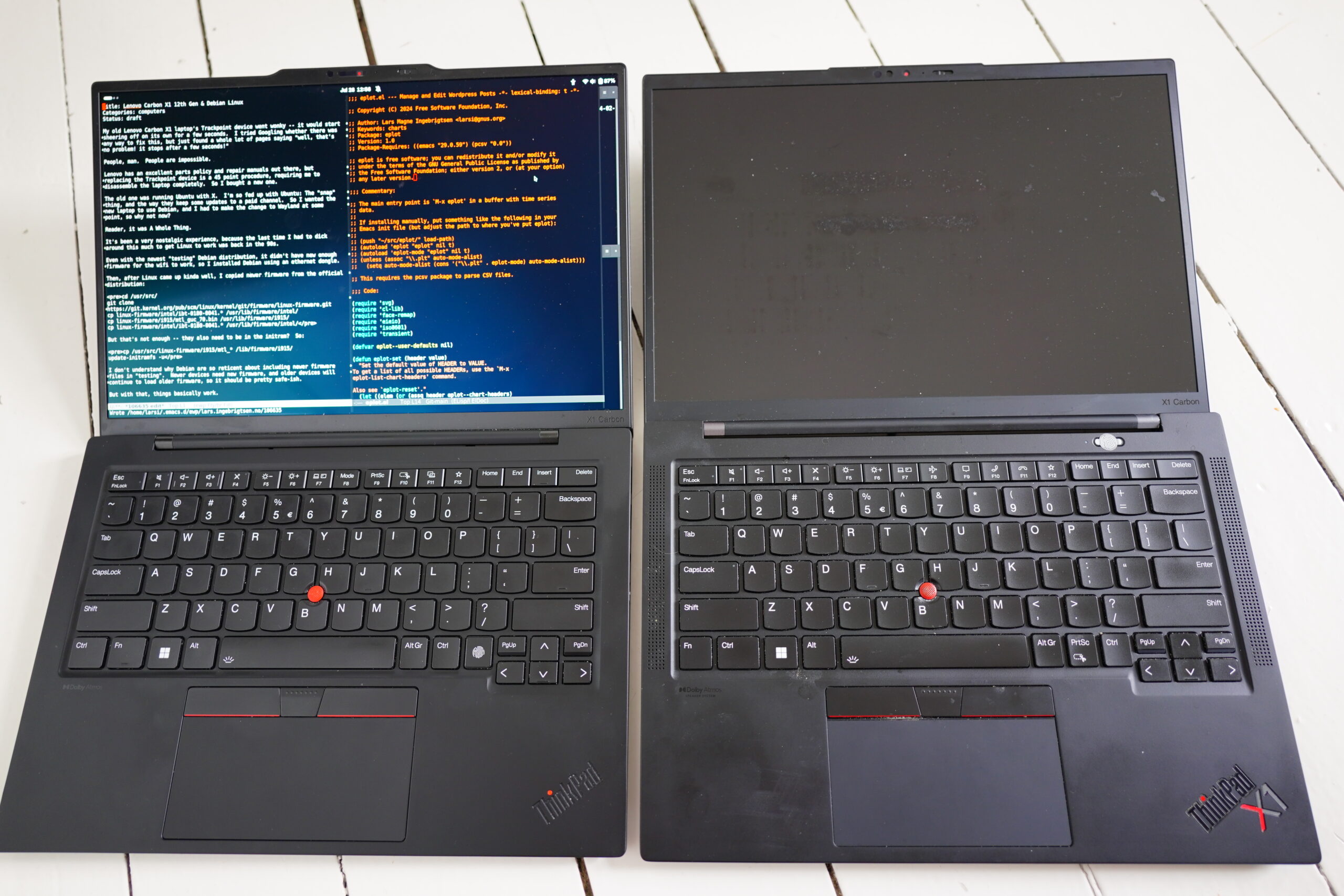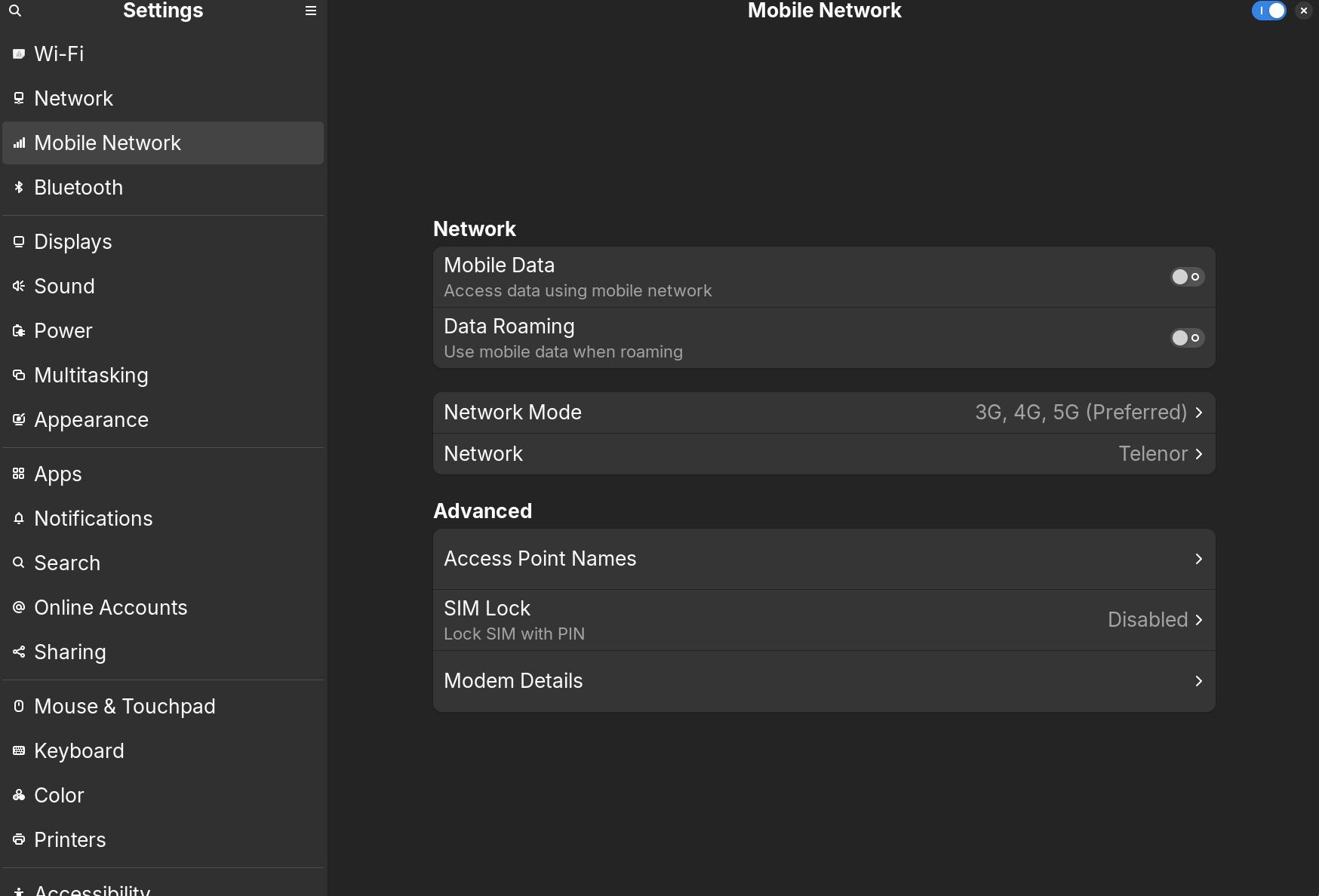This blog post is about installing Debian on the latest Lenovo Carbon X1 — the 12th gen. tl;dr: I wouldn’t really recommend the experience… but the result is the best laptop I’ve had.
OK, here’s my tale of woe and success:
My old Lenovo Carbon X1 laptop’s Trackpoint device went wonky — it would start sheering off on its own for a few seconds. I tried Googling whether there was any way to fix this, but just found a whole lot of pages saying “well, that’s no problem! it stops after a few seconds!”
People, man. People are impossible.
Lenovo has an excellent parts policy and repair manuals out there, but replacing the Trackpoint device is a 45 point procedure, requiring me to disassemble the laptop completely. So I bought a new one.
As you can see, they’re very similar. The main keyboard difference is that there’s now a fingerprint thing where the right control key was, but I didn’t use the right control key anyway, so it makes no difference to me. Oh, and they flipped the Fn/Left Control keys once again.
(I should send the old one in to be fixed, even though it’s out of warranty, I guess…)
The old one was running Ubuntu with X. I’m so fed up with Ubuntu: The “snap” thing, and the way they keep some updates to a paid channel. So I wanted the new laptop to use Debian, and I had to make the change to Wayland at some point, so why not now?
Reader, it was A Whole Thing.
It’s been a very nostalgic experience, because the last time I had to dick around this much to get Linux to work was back in the 90s.
Even with the newest “testing” Debian distribution, it didn’t have new enough firmware for the wifi to work, so I installed Debian using an ethernet dongle. How retro is that?
Then, after Linux came up kinda well, I copied newer firmware from the official distribution:
cd /usr/src/ git clone https://git.kernel.org/pub/scm/linux/kernel/git/firmware/linux-firmware.git cp linux-firmware/intel/ibt-0180-0041.* /usr/lib/firmware/intel/ cp linux-firmware/i915/mtl_guc_70.bin /usr/lib/firmware/i915/ cp linux-firmware/intel/ibt-0180-0041.* /usr/lib/firmware/intel/
But that’s not enough — they also need to be in the initramfs? So:
cp /usr/src/linux-firmware/i915/mtl_* /lib/firmware/i915/ update-initramfs -u
I don’t understand why Debian are so reticent about including newer firmware files in “testing”. Newer devices need new firmware, and older devices will continue to load older firmware, so it should be pretty safe-ish. (I’m guessing wifi would have worked out of the box with Ubuntu, since they (wisely) include newer firmware.)
But with that, the laptop is basically usable, but lots of details remain to get everything to work.
The laptop has a 5G modem installed:
08:00.0 Unassigned class [ff00]: Quectel Wireless Solutions Co., Ltd. Device 1007
This modem (which is really called Quectel RM520N-GL 5G Sub6, apparently) is well supported in Linux 6.9, but it needs to be FCC unlocked, because Lenovo locks them.
So you need this, but you don’t need all of that. But you apparently need ModemManager 1.23, which isn’t in Debian “testing”, so you need to get it from here. And also libmbin.
apt build-dep modemmanager libmbib
to get the requirements.
bash /usr/share/ModemManager/fcc-unlock.available.d/1eac\:1001 foo `ls /sys/class/wwan/`
will unlock, but:
mbimcli --device-open-proxy --device=/dev/wwan0mbim0 --quectel-query-radio-state
will talk about not being able to do anything about the modem, because it’s eSIM. So you need to switch to the physical sim slot:
mmcli -m 0 --set-primary-sim-slot=0
Then reboot, and things work. I.e., just go to Settings and switch it on:
*phew*
I’ve used the 5G on a trip now, and it seems to be rock solid. I’ve had other laptop with built-in WWAN, and it’s generally kinda worked… but often required a bit of hand-holding, and is often not completely stable. But this chipset seems to be A-OK.
The audio system worked fine out of the box… until Debian updated the firmware or something, and then the internal speaker stopped working. I know! It’s such a cliché joke at this point — whenever somebody mentions Linux, they go “and does the audio work, then? *snigger*”, and I haven’t had a problem with Linux audio in years, so my reaction has been “*pout* So unfair! *stamps foot*”.
But to get the laptop speaker working again, I needed the following in /etc/default/grub:
GRUB_CMDLINE_LINUX_DEFAULT="quiet snd_intel_dspcfg.dsp_driver=1"
And then update-grub2.
For the Fn/Ctrl thing, I’ve gotten used to having the Ctrl where it was — but fortunately that could be switched around in the BIOS.
And then, of course, all the pain involved with Wayland.
But the good news is… the Lenovo Carbon X1 12th Gen is really good! It’s fast, and it has way better battery life than I’ve ever experienced on a Linux laptop. Which is a huge difference from my previous laptop, which only lasted like three hours. So the Linux/Intel people have really gotten their shit together and made huge strides in this area.
Speaking of power modes… What do you think these three options mean, anyway? It’s impossible to guess. But after looking at the source code and googling a lot, these three options seem to mean:
- Performance: Be fast, but use a lot of power.
- Power Saver: Be slow, but use next to no power.
- Balanced: Use Performance when plugged in, and Power Saver when unplugged.
That is, there is no Balanced mode really.
And dude, Power Saver mode is dog slow. It ramps up when you’re doing something, but it’s so slow that even typing in Emacs will have a noticeable lag. Balanced mode is the defaults, and makes the laptop a sad experience when unplugged, basically. Before I realised this, I thought perhaps that Wayland was the culprit or something, but was extremely impressed by the 18 hours uptime I was getting. So now I’ve just changed it to flip to Performance when I open the lid, and down to Power Saver when I close the lid.
With my usage patterns (which involve using the laptop often throughout the day, but mixed with doing other stuff in betwee), I basically only have to charge it once per day. I’ve thrown out most of the chargers I had sprinkled around my apt! It makes a huge change in how I feel about the laptop — instead of there being a constant low level “perhaps I should charge it soon” loop going in my head, there’s just this chill thing going on now.
And if I forget to plug the laptop in before going to bed, that’s fine, because when I’m not using the laptop, it only seems to gently sip battery power. (I’ve don’t let the laptop go to “suspend” automatically when not in use, because I’ve got several long-running network connections going all the time, and reconnecting would be a bother.)
And otherwise… everything just works? Suspend (which I never use anyway, because it’s not needed) works fine, audio works fine (ahem), the screen is pretty good (it’s OLED with an anti glare thing — I’d prefer FULL GLARE to get max contrast, but it’s fine). And it’s 1.1kg.
I’d go so far as to say that this is my favourite laptop ever. Despite all the 90s-like shenanigans to get things working. And presumably the next Debian release will have proper support for all of this stuff, so people won’t have to go through all of… this.
(Which is less stuff than I thought now that I’m typing it out, but it sure took me a long time to figure out all these bits and pieces.)
Anyway.
Year Of Linux On The Laptop!





My experience with the X1 series, going back like 15? years, is that they always require these sort of gymnastics with Debian-based systems for the first 1.5-2 years after release. Can’t say I’m surprised but congrats for getting it sorted.
Can I ask if there’s anything beside the battery life you find compelling about this gen of X1 Carbon?
A couple of tangential ideas…
I find that old Carbons make great Proxmox + Nomad “appliances” for sprinkling around a home network. I usually hack them to not suspend on lid close and don’t really have a problem with the thermals very often.
Also, you might consider Regolith 3 desktop on top of Debian as a nice mouse-minimal interface. It works with sway (not just i3) and so you don’t have to think about the snapping stuff anymore.
Thx for the post.
The battery time is definitely the most, er, shocking thing about this — bust I’ve been using Carbon X1s since the 1st gen, and this is the first generation that basically everything works (after all my woes). My previous Carbon didn’t have working suspend, and the 4G modem didn’t work. None of those were really major issues, but it’s sure nice to have them working right.
So the battery thing is the major upgrade, but the other things means that I have an annoyance-free laptop finally, which has never happened before.
Did you manage to buy it without Microsoft Windows? I can only find that option on some Lenovo laptops, sometimes…
Yeah, this model doesn’t come with a Windows-less option, I think. I bought it including the Microsoft Windows Tax…
Update: today it was possible to order it without the Microsoft Windows tax. Yay!
Nice.
Are you a Debian guy? Most of the people I see avoiding Ubuntu’s nonsense and still needing updated software end up going for Fedora… I can’t say much about it, as I always use Debian stable whenever I can, due to familiarity and affection
I suggested Fedora
Yeah, I’ve always used Debian when I can, and Ubuntu when the hardware was too new.
It seems my previous message got cut off (probably my mistake, feel free to remove it @Lars).
I suggested Fedora in a previous post about Wayland issues. I have used it for some time now, and it is cutting edge (no bleeding) while remaining very stable.
And it has defaulted to Wayland for some time now, so a lot of problems have been ironed out.
Appreciate this – just got a Gen 12 in today after melting my Gen 10. Once I went to Debian 12 trixie, I lost the internal mic as a input on Gen 10. I also don’t have it on the Gen 12. I’m trying the
GRUB_CMDLINE_LINUX_DEFAULT=”quiet snd_intel_dspcfg.dsp_driver=1″
and have tried the
firmware-sof-signed
package but no dice.
We’ll see how it goes. Thanks!
I am still unable to get the ipu6 camera going. Tried everything. Seems like it should go now with more ipu6 support on the kernel. If anyone has the clue please send my way.
Same for me, camera is not working on Debian Trixie (testing), I tried installing https://github.com/intel/ipu6-drivers or newer kernels (from experimental), with no luck.
After the latest Debian update, both Bluetooth and the 5G modem stopped working, and I haven’t had enough energy to find out why. It’s a very nostalgic experience indeed.
Thanks – yeah, I guess it’s not just me. I will keep looking around. If I find something that works, I will share out.
RE: ipu6 webcam
Yeah, did all the ipu6 github repo compiles and kernel modules, recompiled kernels directly as well forcing various and meh. Everything else is now fine (came from a X1 Carbon Gen 10) but tough not to fixate on that ipu6 cam not operational. After all the intel ipu6 compiles and kernal mods, I started to not even see it anymore in hardware or software so I backed it all out and at lease I am seeing an ipu6 camera in Zoom, etc. but is not operational.
Continue to get a lot of these at boot.
[ 11.373903] int3472-discrete INT3472:0b: cannot find GPIO chip INTC1007:00, deferring
[ 11.578983] int3472-discrete INT3472:0c: cannot find GPIO chip INTC1007:00, deferring
[ 11.579719] int3472-discrete INT3472:0b: GPIO type 0x12 unknown; the sensor may not work
I even emailed the guy that maintains the int3472-discrete mod and nada.